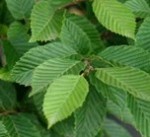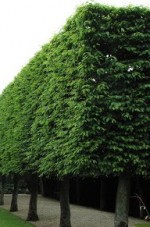 With its fine texture and beautiful oval to round crown, European hornbeam is an excellent tree for the home landscape. It can be pruned and sheared repeatedly so can be used in tall hedges and pleached allees as well as in containers and as a specimen. The leaves are dainty with serrated edges and dark green in summer turning yellow to yellow-green in the fall. The flowers are inconspicuous and appear in the spring followed by single-winged fruits. The bark of a mature tree is fluted and slate gray. The wood is hard, heavy and tough and may dull tools. Native to southern Europe and Asia, the species is rarely grown but the columnar cultivar ‘Fastigiata’ is widely grown in North America as a street tree because of its heat and drought resistance as well as its relatively small size.
With its fine texture and beautiful oval to round crown, European hornbeam is an excellent tree for the home landscape. It can be pruned and sheared repeatedly so can be used in tall hedges and pleached allees as well as in containers and as a specimen. The leaves are dainty with serrated edges and dark green in summer turning yellow to yellow-green in the fall. The flowers are inconspicuous and appear in the spring followed by single-winged fruits. The bark of a mature tree is fluted and slate gray. The wood is hard, heavy and tough and may dull tools. Native to southern Europe and Asia, the species is rarely grown but the columnar cultivar ‘Fastigiata’ is widely grown in North America as a street tree because of its heat and drought resistance as well as its relatively small size.

Type: Deciduous tree
Outstanding Feature: Ability to be sheared and pruned repeatedly; fall coloration
Form: Pyramidal when young; oval to round at maturity
Growth Rate: Slow to medium
Bloom: Inconspicuous white to creamy; male and female catkins; spring
Size: Usually 40-60’ H x 30-40’ W
Light: Full sun; tolerates dappled shade
Soil: Average, moist, well-drained; adapts to many types of soil.
Hardiness: Zones 5-7
Care: Prune in August or after the leaves fall to shape as desired
Pests and Diseases: None of significance
Propagation: The species can be propagated by seed but will be very variable; cultivars may be propagated by vegetative cuttings; plants are difficult to transplant.
Outstanding Selections:
- ‘Fastigiata’ (columnar, about 35’ H)
- ‘Asplenifolia’ (lacy-textured leaves)
- ‘Pendulata’ (weeping)
